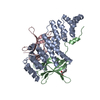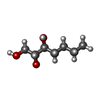[English] 日本語
 Yorodumi
Yorodumi- PDB-9bor: IkappaBzeta ankyrin repeat domain:NF-kappaB p50 homodimer complex... -
+ Open data
Open data
- Basic information
Basic information
| Entry | Database: PDB / ID: 9bor | ||||||
|---|---|---|---|---|---|---|---|
| Title | IkappaBzeta ankyrin repeat domain:NF-kappaB p50 homodimer complex at 2.0 Angstrom resolution | ||||||
 Components Components |
| ||||||
 Keywords Keywords | TRANSCRIPTION / Transcription factor / immunoglobulin-like domain / ankyrin repeat domain / protein-protein complex / NF-kappaB / IkappaB | ||||||
| Function / homology |  Function and homology information Function and homology informationkeratinocyte activation / response to cisplatin / positive regulation of T-helper 17 cell differentiation / Regulated proteolysis of p75NTR / I-kappaB/NF-kappaB complex / negative regulation of vitamin D biosynthetic process / B cell receptor apoptotic signaling pathway / Interleukin-1 processing / chronic inflammatory response / transcription preinitiation complex assembly ...keratinocyte activation / response to cisplatin / positive regulation of T-helper 17 cell differentiation / Regulated proteolysis of p75NTR / I-kappaB/NF-kappaB complex / negative regulation of vitamin D biosynthetic process / B cell receptor apoptotic signaling pathway / Interleukin-1 processing / chronic inflammatory response / transcription preinitiation complex assembly / DEx/H-box helicases activate type I IFN and inflammatory cytokines production / RIP-mediated NFkB activation via ZBP1 / MAP3K8 (TPL2)-dependent MAPK1/3 activation / TRAF6 mediated NF-kB activation / T-helper 1 cell differentiation / positive regulation of hyaluronan biosynthetic process / response to Gram-positive bacterium / NF-kB is activated and signals survival / PKMTs methylate histone lysines / Activation of NF-kappaB in B cells / TAK1-dependent IKK and NF-kappa-B activation / mammary gland involution / Turbulent (oscillatory, disturbed) flow shear stress activates signaling by PIEZO1 and integrins in endothelial cells / FCERI mediated NF-kB activation / CLEC7A (Dectin-1) signaling / POU domain binding / Interleukin-1 signaling / antibacterial innate immune response / Downstream TCR signaling / T cell mediated immunity / cellular response to interleukin-17 / NF-kappaB p50/p65 complex / inflammatory response to wounding / T-helper 17 cell differentiation / CD209 (DC-SIGN) signaling / response to folic acid / positive regulation of lipid storage / negative regulation of interleukin-12 production / isotype switching / cellular response to interleukin-6 / positive regulation of macrophage derived foam cell differentiation / plasma cell differentiation / cellular response to dsRNA / non-canonical NF-kappaB signal transduction / actinin binding / positive regulation of miRNA metabolic process / epithelial cell apoptotic process / signal transduction involved in regulation of gene expression / execution phase of apoptosis / negative regulation of cytokine production / toll-like receptor signaling pathway / cellular response to cytokine stimulus / B cell proliferation / cellular response to angiotensin / keratinocyte proliferation / positive regulation of cholesterol efflux / canonical NF-kappaB signal transduction / lymph node development / establishment of skin barrier / positive regulation of transcription initiation by RNA polymerase II / cellular response to transforming growth factor beta stimulus / spleen development / keratinocyte differentiation / JNK cascade / response to muscle stretch / Neutrophil degranulation / negative regulation of cytokine production involved in inflammatory response / homeostasis of number of cells within a tissue / B cell receptor signaling pathway / transcription coregulator activity / RNA polymerase II transcription regulatory region sequence-specific DNA binding / mRNA transcription by RNA polymerase II / cellular response to mechanical stimulus / cellular response to virus / cellular response to nicotine / DNA-binding transcription repressor activity, RNA polymerase II-specific / negative regulation of inflammatory response / cytokine-mediated signaling pathway / cytoplasmic ribonucleoprotein granule / positive regulation of inflammatory response / cellular response to tumor necrosis factor / positive regulation of canonical Wnt signaling pathway / T cell receptor signaling pathway / MAPK cascade / cellular response to lipopolysaccharide / regulation of gene expression / DNA-binding transcription activator activity, RNA polymerase II-specific / transcription regulator complex / defense response to Gram-negative bacterium / gene expression / sequence-specific DNA binding / transcription cis-regulatory region binding / nuclear speck / RNA polymerase II cis-regulatory region sequence-specific DNA binding / chromatin remodeling / DNA-binding transcription factor activity / response to xenobiotic stimulus / negative regulation of DNA-templated transcription / apoptotic process / chromatin binding Similarity search - Function | ||||||
| Biological species |  Homo sapiens (human) Homo sapiens (human) | ||||||
| Method |  X-RAY DIFFRACTION / X-RAY DIFFRACTION /  SYNCHROTRON / SYNCHROTRON /  MOLECULAR REPLACEMENT / Resolution: 1.997 Å MOLECULAR REPLACEMENT / Resolution: 1.997 Å | ||||||
 Authors Authors | Rogers, W.E. / Zhu, N. / Huxford, T. | ||||||
| Funding support |  United States, 1items United States, 1items
| ||||||
 Citation Citation |  Journal: Genes Dev. / Year: 2024 Journal: Genes Dev. / Year: 2024Title: Structural and biochemical analyses of the nuclear I kappa B zeta protein in complex with the NF-kappa B p50 homodimer. Authors: Zhu, N. / Rogers, W.E. / Heidary, D.K. / Huxford, T. | ||||||
| History |
|
- Structure visualization
Structure visualization
| Structure viewer | Molecule:  Molmil Molmil Jmol/JSmol Jmol/JSmol |
|---|
- Downloads & links
Downloads & links
- Download
Download
| PDBx/mmCIF format |  9bor.cif.gz 9bor.cif.gz | 127 KB | Display |  PDBx/mmCIF format PDBx/mmCIF format |
|---|---|---|---|---|
| PDB format |  pdb9bor.ent.gz pdb9bor.ent.gz | 96 KB | Display |  PDB format PDB format |
| PDBx/mmJSON format |  9bor.json.gz 9bor.json.gz | Tree view |  PDBx/mmJSON format PDBx/mmJSON format | |
| Others |  Other downloads Other downloads |
-Validation report
| Summary document |  9bor_validation.pdf.gz 9bor_validation.pdf.gz | 460.6 KB | Display |  wwPDB validaton report wwPDB validaton report |
|---|---|---|---|---|
| Full document |  9bor_full_validation.pdf.gz 9bor_full_validation.pdf.gz | 467.1 KB | Display | |
| Data in XML |  9bor_validation.xml.gz 9bor_validation.xml.gz | 24.2 KB | Display | |
| Data in CIF |  9bor_validation.cif.gz 9bor_validation.cif.gz | 34.8 KB | Display | |
| Arichive directory |  https://data.pdbj.org/pub/pdb/validation_reports/bo/9bor https://data.pdbj.org/pub/pdb/validation_reports/bo/9bor ftp://data.pdbj.org/pub/pdb/validation_reports/bo/9bor ftp://data.pdbj.org/pub/pdb/validation_reports/bo/9bor | HTTPS FTP |
-Related structure data
| Related structure data |  4trv S: Starting model for refinement |
|---|---|
| Similar structure data | Similarity search - Function & homology  F&H Search F&H Search |
- Links
Links
- Assembly
Assembly
| Deposited unit | 
| ||||||||
|---|---|---|---|---|---|---|---|---|---|
| 1 |
| ||||||||
| Unit cell |
|
- Components
Components
| #1: Protein | Mass: 34773.613 Da / Num. of mol.: 1 Source method: isolated from a genetically manipulated source Source: (gene. exp.)  Homo sapiens (human) / Gene: NFKBIZ, IKBZ, INAP, MAIL / Production host: Homo sapiens (human) / Gene: NFKBIZ, IKBZ, INAP, MAIL / Production host:  | ||||||
|---|---|---|---|---|---|---|---|
| #2: Protein | Mass: 15227.196 Da / Num. of mol.: 2 Source method: isolated from a genetically manipulated source Details: C and N terminus unstable and not modeled / Source: (gene. exp.)   #3: Chemical | ChemComp-HT3 / ( | #4: Water | ChemComp-HOH / | Has ligand of interest | N | |
-Experimental details
-Experiment
| Experiment | Method:  X-RAY DIFFRACTION / Number of used crystals: 1 X-RAY DIFFRACTION / Number of used crystals: 1 |
|---|
- Sample preparation
Sample preparation
| Crystal | Density Matthews: 2.49 Å3/Da / Density % sol: 50.7 % |
|---|---|
| Crystal grow | Temperature: 303 K / Method: vapor diffusion, hanging drop Details: 20mM acetic acid pH 5.2, 80mM acetic acid pH 5.8, 5.5% PEG 3350, 10mM DTT, 0.5% 1,2,3 heptanetriol PH range: 5.2-5.8 |
-Data collection
| Diffraction | Mean temperature: 100 K / Serial crystal experiment: N |
|---|---|
| Diffraction source | Source:  SYNCHROTRON / Site: SYNCHROTRON / Site:  ALS ALS  / Beamline: 8.2.2 / Wavelength: 0.99 Å / Beamline: 8.2.2 / Wavelength: 0.99 Å |
| Detector | Type: ADSC QUANTUM 315r / Detector: CCD / Date: Jun 15, 2012 |
| Radiation | Protocol: SINGLE WAVELENGTH / Monochromatic (M) / Laue (L): M / Scattering type: x-ray |
| Radiation wavelength | Wavelength: 0.99 Å / Relative weight: 1 |
| Reflection | Resolution: 1.997→50 Å / Num. all: 43896 / Num. obs: 43393 / % possible obs: 98.89 % / Observed criterion σ(I): 2 / Redundancy: 3.6 % / Rsym value: 0.055 / Net I/σ(I): 20.4 |
| Reflection shell | Resolution: 1.997→2.041 Å / Mean I/σ(I) obs: 2.097 / Num. unique obs: 2608 / Rsym value: 0.468 / % possible all: 96.51 |
- Processing
Processing
| Software |
| |||||||||||||||||||||||||||||||||||||||||||||||||||||||||||||||||||||||||||||||||||||||||||||||||||||||||||||||||||||||
|---|---|---|---|---|---|---|---|---|---|---|---|---|---|---|---|---|---|---|---|---|---|---|---|---|---|---|---|---|---|---|---|---|---|---|---|---|---|---|---|---|---|---|---|---|---|---|---|---|---|---|---|---|---|---|---|---|---|---|---|---|---|---|---|---|---|---|---|---|---|---|---|---|---|---|---|---|---|---|---|---|---|---|---|---|---|---|---|---|---|---|---|---|---|---|---|---|---|---|---|---|---|---|---|---|---|---|---|---|---|---|---|---|---|---|---|---|---|---|---|---|
| Refinement | Method to determine structure:  MOLECULAR REPLACEMENT MOLECULAR REPLACEMENTStarting model: 4TRV  4trv Resolution: 1.997→43.31 Å / SU ML: 0.22 / Cross valid method: FREE R-VALUE / σ(F): 1.34 / Phase error: 22.94 / Stereochemistry target values: ML
| |||||||||||||||||||||||||||||||||||||||||||||||||||||||||||||||||||||||||||||||||||||||||||||||||||||||||||||||||||||||
| Solvent computation | Shrinkage radii: 0.9 Å / VDW probe radii: 1.11 Å / Solvent model: FLAT BULK SOLVENT MODEL | |||||||||||||||||||||||||||||||||||||||||||||||||||||||||||||||||||||||||||||||||||||||||||||||||||||||||||||||||||||||
| Displacement parameters | Biso mean: 44.93 Å2 | |||||||||||||||||||||||||||||||||||||||||||||||||||||||||||||||||||||||||||||||||||||||||||||||||||||||||||||||||||||||
| Refinement step | Cycle: LAST / Resolution: 1.997→43.31 Å
| |||||||||||||||||||||||||||||||||||||||||||||||||||||||||||||||||||||||||||||||||||||||||||||||||||||||||||||||||||||||
| Refine LS restraints |
| |||||||||||||||||||||||||||||||||||||||||||||||||||||||||||||||||||||||||||||||||||||||||||||||||||||||||||||||||||||||
| LS refinement shell |
|
 Movie
Movie Controller
Controller


 PDBj
PDBj
























